Organisational Behaviour: CAPCO, Argo SE, and Leadership Styles
VerifiedAdded on 2019/12/04
|21
|7723
|173
Report
AI Summary
This report delves into the realm of organisational behaviour, examining the intricate interplay between organisational structure, culture, and leadership styles within the context of two companies: CAPCO and Argo SE. The report commences by contrasting the organisational structures and cultures of CAPCO and Argo SE, highlighting how these elements influence business performance. It further explores the factors shaping individual behaviour in the workplace, including leadership styles, job satisfaction, and the perception of fairness. The report then compares the effectiveness of different leadership styles across various organisations, evaluates the role of organisational theory in management practices, and assesses diverse approaches to management. Furthermore, the report investigates the influence of leadership styles on employee motivation during periods of change, compares the application of motivational theories, and discusses the practical usefulness of such theories for managers. The analysis extends to the nature of groups and teamwork within organisations, identifying factors that either promote or hinder effective collaboration, while also considering the impact of technology on team functioning. The report concludes by synthesizing the key findings and offering insights into the complex dynamics of organisational behaviour and its implications for business success.
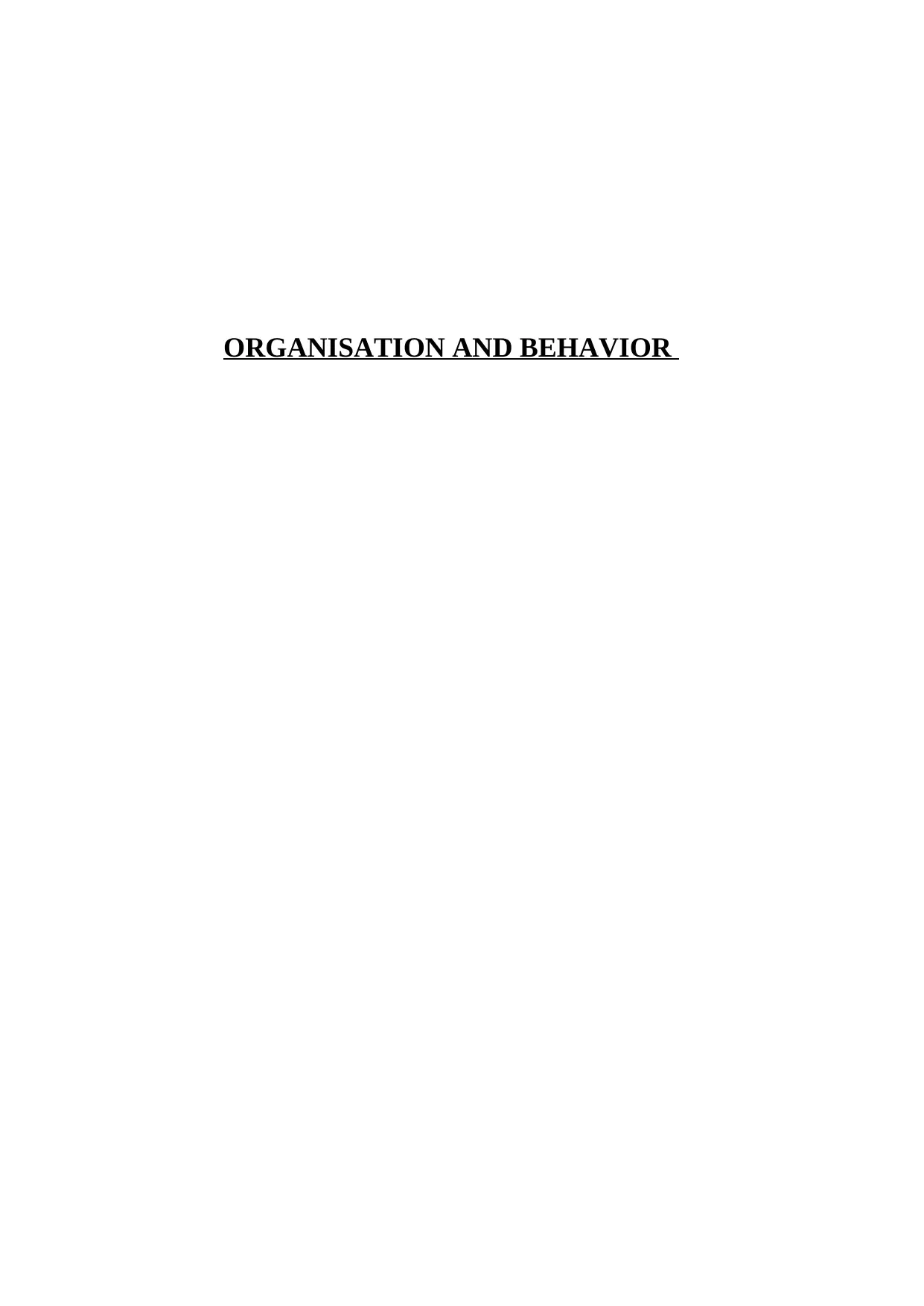
ORGANISATION AND BEHAVIOR
Paraphrase This Document
Need a fresh take? Get an instant paraphrase of this document with our AI Paraphraser
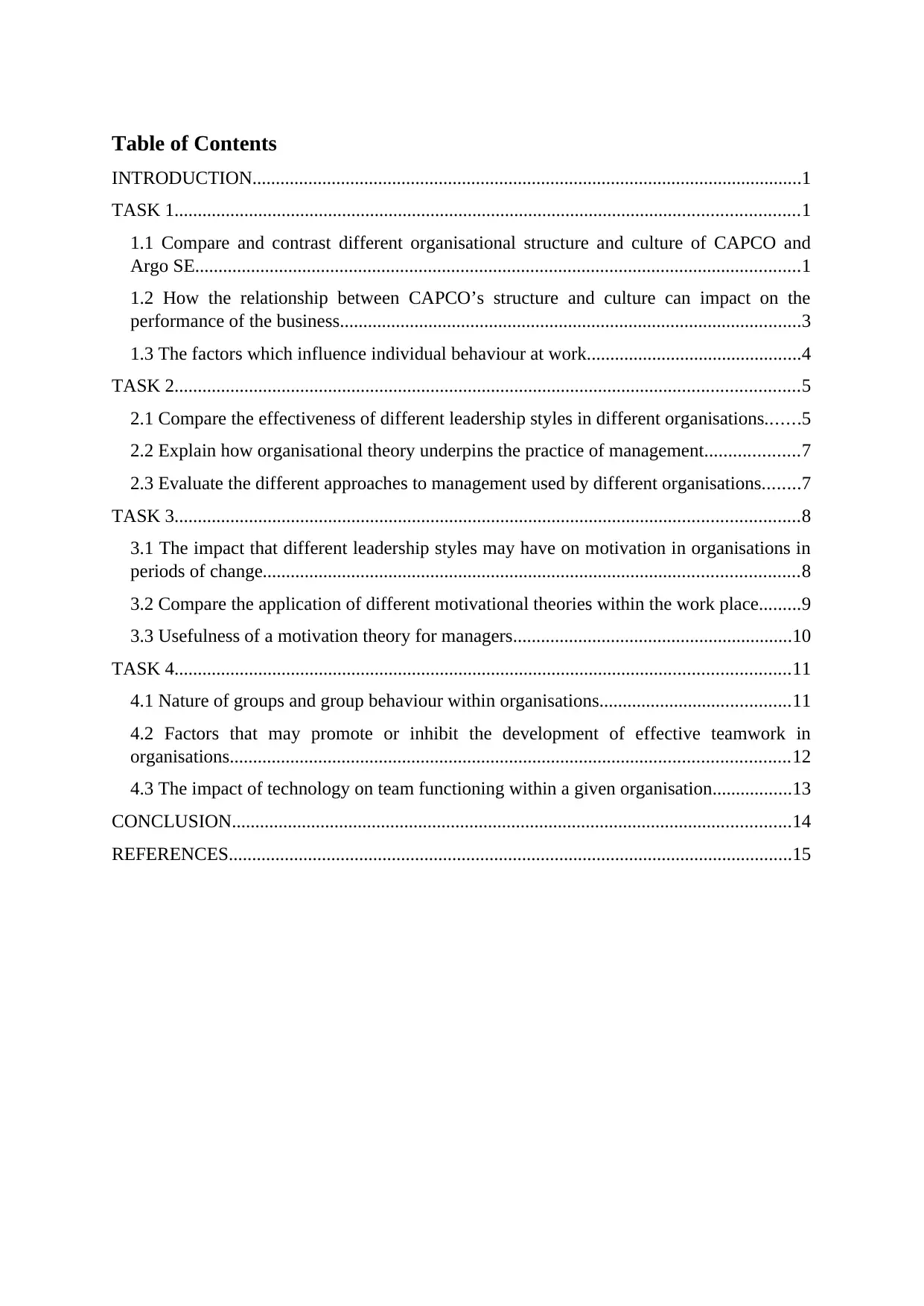
Table of Contents
INTRODUCTION......................................................................................................................1
TASK 1......................................................................................................................................1
1.1 Compare and contrast different organisational structure and culture of CAPCO and
Argo SE..................................................................................................................................1
1.2 How the relationship between CAPCO’s structure and culture can impact on the
performance of the business...................................................................................................3
1.3 The factors which influence individual behaviour at work..............................................4
TASK 2......................................................................................................................................5
2.1 Compare the effectiveness of different leadership styles in different organisations.......5
2.2 Explain how organisational theory underpins the practice of management....................7
2.3 Evaluate the different approaches to management used by different organisations........7
TASK 3......................................................................................................................................8
3.1 The impact that different leadership styles may have on motivation in organisations in
periods of change...................................................................................................................8
3.2 Compare the application of different motivational theories within the work place.........9
3.3 Usefulness of a motivation theory for managers............................................................10
TASK 4....................................................................................................................................11
4.1 Nature of groups and group behaviour within organisations.........................................11
4.2 Factors that may promote or inhibit the development of effective teamwork in
organisations........................................................................................................................12
4.3 The impact of technology on team functioning within a given organisation.................13
CONCLUSION........................................................................................................................14
REFERENCES.........................................................................................................................15
INTRODUCTION......................................................................................................................1
TASK 1......................................................................................................................................1
1.1 Compare and contrast different organisational structure and culture of CAPCO and
Argo SE..................................................................................................................................1
1.2 How the relationship between CAPCO’s structure and culture can impact on the
performance of the business...................................................................................................3
1.3 The factors which influence individual behaviour at work..............................................4
TASK 2......................................................................................................................................5
2.1 Compare the effectiveness of different leadership styles in different organisations.......5
2.2 Explain how organisational theory underpins the practice of management....................7
2.3 Evaluate the different approaches to management used by different organisations........7
TASK 3......................................................................................................................................8
3.1 The impact that different leadership styles may have on motivation in organisations in
periods of change...................................................................................................................8
3.2 Compare the application of different motivational theories within the work place.........9
3.3 Usefulness of a motivation theory for managers............................................................10
TASK 4....................................................................................................................................11
4.1 Nature of groups and group behaviour within organisations.........................................11
4.2 Factors that may promote or inhibit the development of effective teamwork in
organisations........................................................................................................................12
4.3 The impact of technology on team functioning within a given organisation.................13
CONCLUSION........................................................................................................................14
REFERENCES.........................................................................................................................15
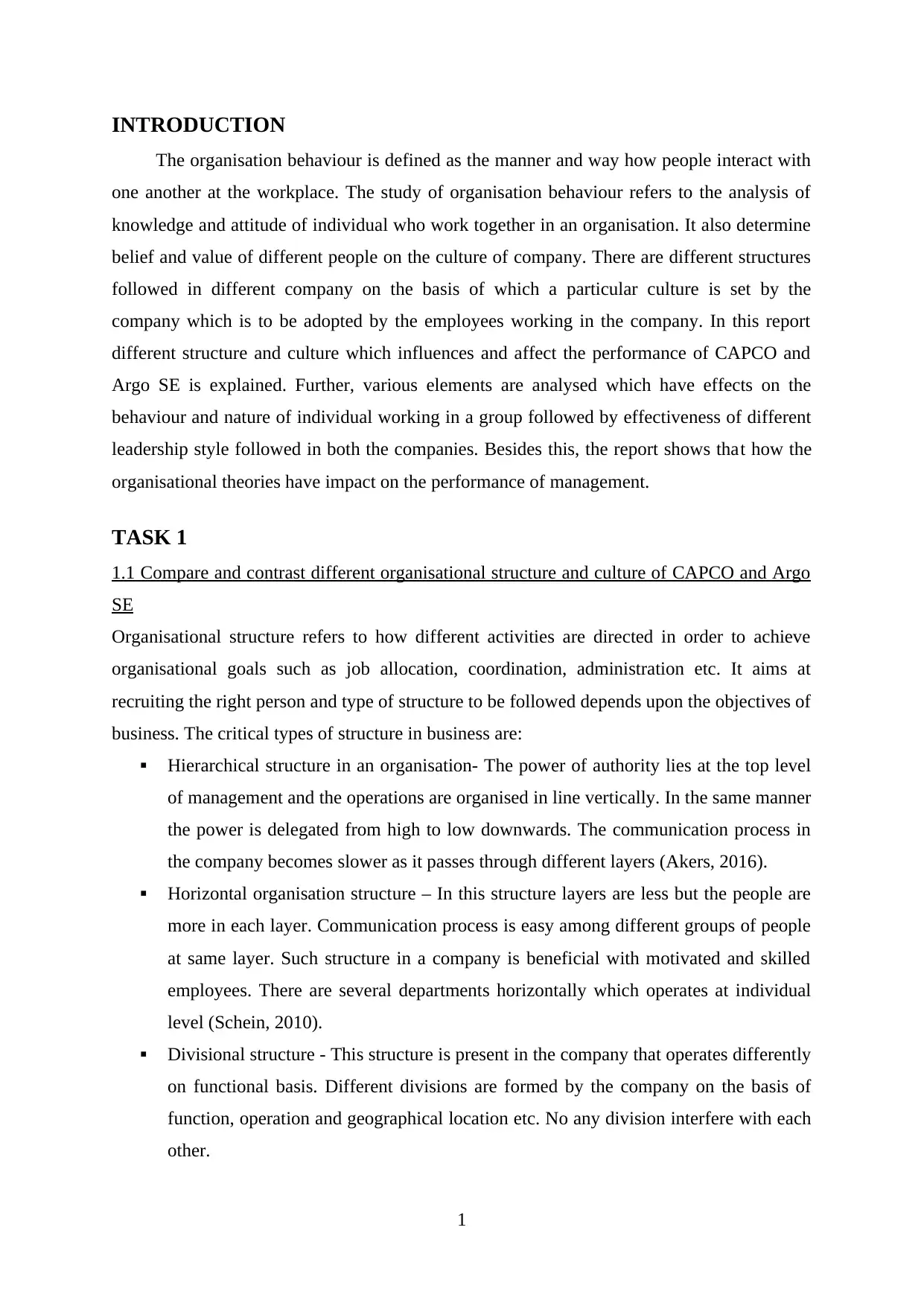
INTRODUCTION
The organisation behaviour is defined as the manner and way how people interact with
one another at the workplace. The study of organisation behaviour refers to the analysis of
knowledge and attitude of individual who work together in an organisation. It also determine
belief and value of different people on the culture of company. There are different structures
followed in different company on the basis of which a particular culture is set by the
company which is to be adopted by the employees working in the company. In this report
different structure and culture which influences and affect the performance of CAPCO and
Argo SE is explained. Further, various elements are analysed which have effects on the
behaviour and nature of individual working in a group followed by effectiveness of different
leadership style followed in both the companies. Besides this, the report shows that how the
organisational theories have impact on the performance of management.
TASK 1
1.1 Compare and contrast different organisational structure and culture of CAPCO and Argo
SE
Organisational structure refers to how different activities are directed in order to achieve
organisational goals such as job allocation, coordination, administration etc. It aims at
recruiting the right person and type of structure to be followed depends upon the objectives of
business. The critical types of structure in business are:
Hierarchical structure in an organisation- The power of authority lies at the top level
of management and the operations are organised in line vertically. In the same manner
the power is delegated from high to low downwards. The communication process in
the company becomes slower as it passes through different layers (Akers, 2016).
Horizontal organisation structure – In this structure layers are less but the people are
more in each layer. Communication process is easy among different groups of people
at same layer. Such structure in a company is beneficial with motivated and skilled
employees. There are several departments horizontally which operates at individual
level (Schein, 2010).
Divisional structure - This structure is present in the company that operates differently
on functional basis. Different divisions are formed by the company on the basis of
function, operation and geographical location etc. No any division interfere with each
other.
1
The organisation behaviour is defined as the manner and way how people interact with
one another at the workplace. The study of organisation behaviour refers to the analysis of
knowledge and attitude of individual who work together in an organisation. It also determine
belief and value of different people on the culture of company. There are different structures
followed in different company on the basis of which a particular culture is set by the
company which is to be adopted by the employees working in the company. In this report
different structure and culture which influences and affect the performance of CAPCO and
Argo SE is explained. Further, various elements are analysed which have effects on the
behaviour and nature of individual working in a group followed by effectiveness of different
leadership style followed in both the companies. Besides this, the report shows that how the
organisational theories have impact on the performance of management.
TASK 1
1.1 Compare and contrast different organisational structure and culture of CAPCO and Argo
SE
Organisational structure refers to how different activities are directed in order to achieve
organisational goals such as job allocation, coordination, administration etc. It aims at
recruiting the right person and type of structure to be followed depends upon the objectives of
business. The critical types of structure in business are:
Hierarchical structure in an organisation- The power of authority lies at the top level
of management and the operations are organised in line vertically. In the same manner
the power is delegated from high to low downwards. The communication process in
the company becomes slower as it passes through different layers (Akers, 2016).
Horizontal organisation structure – In this structure layers are less but the people are
more in each layer. Communication process is easy among different groups of people
at same layer. Such structure in a company is beneficial with motivated and skilled
employees. There are several departments horizontally which operates at individual
level (Schein, 2010).
Divisional structure - This structure is present in the company that operates differently
on functional basis. Different divisions are formed by the company on the basis of
function, operation and geographical location etc. No any division interfere with each
other.
1
⊘ This is a preview!⊘
Do you want full access?
Subscribe today to unlock all pages.

Trusted by 1+ million students worldwide
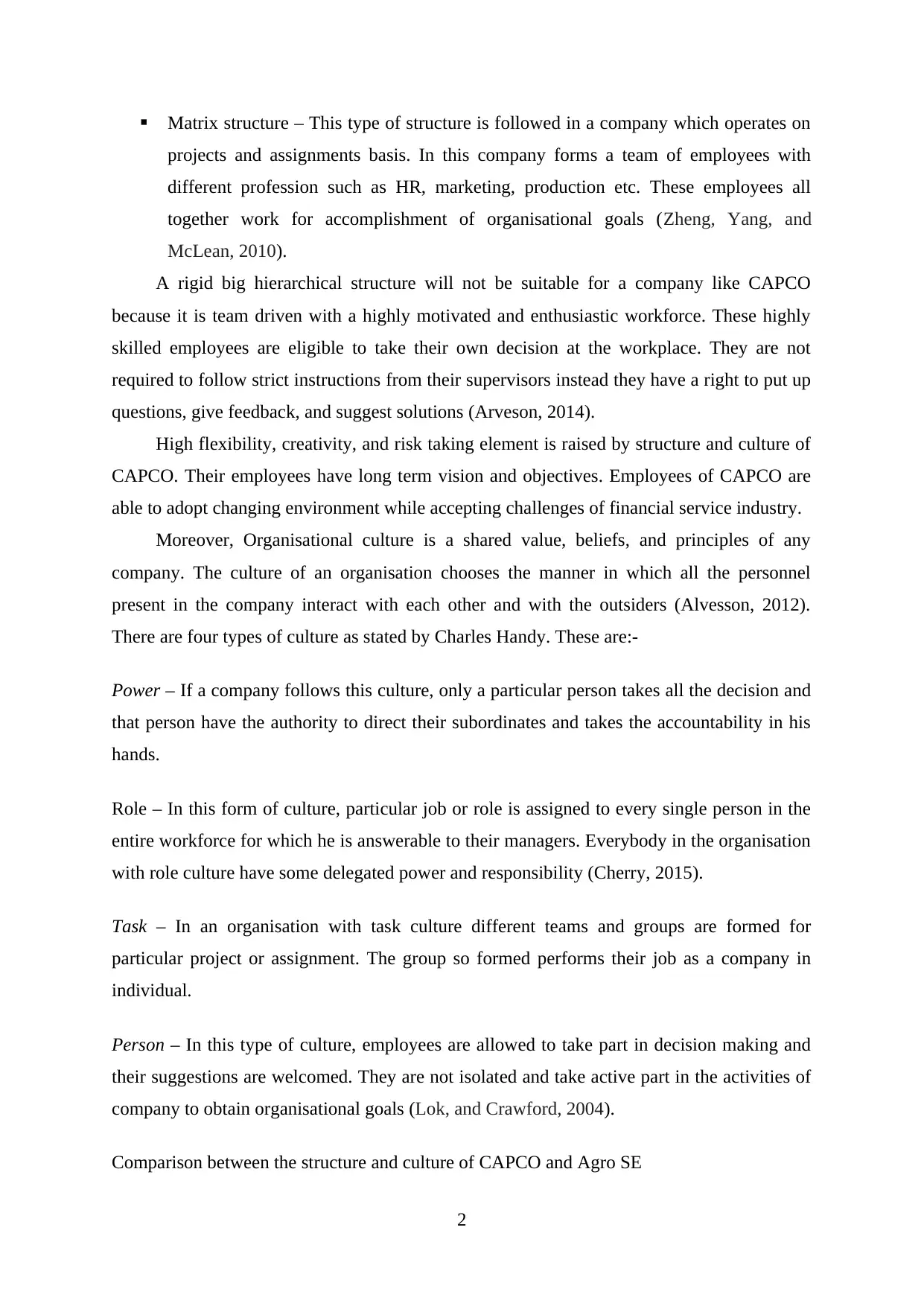
Matrix structure – This type of structure is followed in a company which operates on
projects and assignments basis. In this company forms a team of employees with
different profession such as HR, marketing, production etc. These employees all
together work for accomplishment of organisational goals (Zheng, Yang, and
McLean, 2010).
A rigid big hierarchical structure will not be suitable for a company like CAPCO
because it is team driven with a highly motivated and enthusiastic workforce. These highly
skilled employees are eligible to take their own decision at the workplace. They are not
required to follow strict instructions from their supervisors instead they have a right to put up
questions, give feedback, and suggest solutions (Arveson, 2014).
High flexibility, creativity, and risk taking element is raised by structure and culture of
CAPCO. Their employees have long term vision and objectives. Employees of CAPCO are
able to adopt changing environment while accepting challenges of financial service industry.
Moreover, Organisational culture is a shared value, beliefs, and principles of any
company. The culture of an organisation chooses the manner in which all the personnel
present in the company interact with each other and with the outsiders (Alvesson, 2012).
There are four types of culture as stated by Charles Handy. These are:-
Power – If a company follows this culture, only a particular person takes all the decision and
that person have the authority to direct their subordinates and takes the accountability in his
hands.
Role – In this form of culture, particular job or role is assigned to every single person in the
entire workforce for which he is answerable to their managers. Everybody in the organisation
with role culture have some delegated power and responsibility (Cherry, 2015).
Task – In an organisation with task culture different teams and groups are formed for
particular project or assignment. The group so formed performs their job as a company in
individual.
Person – In this type of culture, employees are allowed to take part in decision making and
their suggestions are welcomed. They are not isolated and take active part in the activities of
company to obtain organisational goals (Lok, and Crawford, 2004).
Comparison between the structure and culture of CAPCO and Agro SE
2
projects and assignments basis. In this company forms a team of employees with
different profession such as HR, marketing, production etc. These employees all
together work for accomplishment of organisational goals (Zheng, Yang, and
McLean, 2010).
A rigid big hierarchical structure will not be suitable for a company like CAPCO
because it is team driven with a highly motivated and enthusiastic workforce. These highly
skilled employees are eligible to take their own decision at the workplace. They are not
required to follow strict instructions from their supervisors instead they have a right to put up
questions, give feedback, and suggest solutions (Arveson, 2014).
High flexibility, creativity, and risk taking element is raised by structure and culture of
CAPCO. Their employees have long term vision and objectives. Employees of CAPCO are
able to adopt changing environment while accepting challenges of financial service industry.
Moreover, Organisational culture is a shared value, beliefs, and principles of any
company. The culture of an organisation chooses the manner in which all the personnel
present in the company interact with each other and with the outsiders (Alvesson, 2012).
There are four types of culture as stated by Charles Handy. These are:-
Power – If a company follows this culture, only a particular person takes all the decision and
that person have the authority to direct their subordinates and takes the accountability in his
hands.
Role – In this form of culture, particular job or role is assigned to every single person in the
entire workforce for which he is answerable to their managers. Everybody in the organisation
with role culture have some delegated power and responsibility (Cherry, 2015).
Task – In an organisation with task culture different teams and groups are formed for
particular project or assignment. The group so formed performs their job as a company in
individual.
Person – In this type of culture, employees are allowed to take part in decision making and
their suggestions are welcomed. They are not isolated and take active part in the activities of
company to obtain organisational goals (Lok, and Crawford, 2004).
Comparison between the structure and culture of CAPCO and Agro SE
2
Paraphrase This Document
Need a fresh take? Get an instant paraphrase of this document with our AI Paraphraser
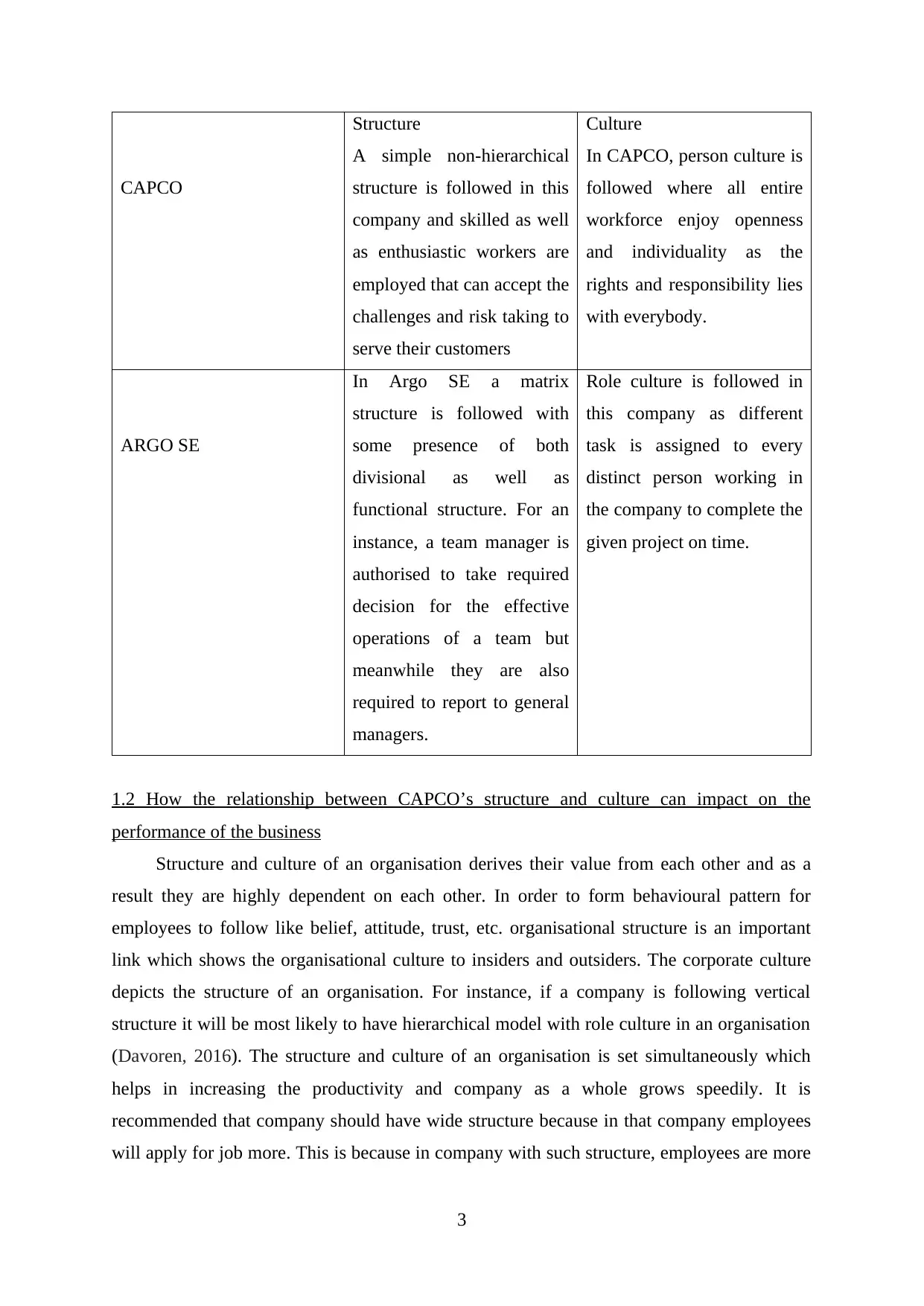
CAPCO
Structure
A simple non-hierarchical
structure is followed in this
company and skilled as well
as enthusiastic workers are
employed that can accept the
challenges and risk taking to
serve their customers
Culture
In CAPCO, person culture is
followed where all entire
workforce enjoy openness
and individuality as the
rights and responsibility lies
with everybody.
ARGO SE
In Argo SE a matrix
structure is followed with
some presence of both
divisional as well as
functional structure. For an
instance, a team manager is
authorised to take required
decision for the effective
operations of a team but
meanwhile they are also
required to report to general
managers.
Role culture is followed in
this company as different
task is assigned to every
distinct person working in
the company to complete the
given project on time.
1.2 How the relationship between CAPCO’s structure and culture can impact on the
performance of the business
Structure and culture of an organisation derives their value from each other and as a
result they are highly dependent on each other. In order to form behavioural pattern for
employees to follow like belief, attitude, trust, etc. organisational structure is an important
link which shows the organisational culture to insiders and outsiders. The corporate culture
depicts the structure of an organisation. For instance, if a company is following vertical
structure it will be most likely to have hierarchical model with role culture in an organisation
(Davoren, 2016). The structure and culture of an organisation is set simultaneously which
helps in increasing the productivity and company as a whole grows speedily. It is
recommended that company should have wide structure because in that company employees
will apply for job more. This is because in company with such structure, employees are more
3
Structure
A simple non-hierarchical
structure is followed in this
company and skilled as well
as enthusiastic workers are
employed that can accept the
challenges and risk taking to
serve their customers
Culture
In CAPCO, person culture is
followed where all entire
workforce enjoy openness
and individuality as the
rights and responsibility lies
with everybody.
ARGO SE
In Argo SE a matrix
structure is followed with
some presence of both
divisional as well as
functional structure. For an
instance, a team manager is
authorised to take required
decision for the effective
operations of a team but
meanwhile they are also
required to report to general
managers.
Role culture is followed in
this company as different
task is assigned to every
distinct person working in
the company to complete the
given project on time.
1.2 How the relationship between CAPCO’s structure and culture can impact on the
performance of the business
Structure and culture of an organisation derives their value from each other and as a
result they are highly dependent on each other. In order to form behavioural pattern for
employees to follow like belief, attitude, trust, etc. organisational structure is an important
link which shows the organisational culture to insiders and outsiders. The corporate culture
depicts the structure of an organisation. For instance, if a company is following vertical
structure it will be most likely to have hierarchical model with role culture in an organisation
(Davoren, 2016). The structure and culture of an organisation is set simultaneously which
helps in increasing the productivity and company as a whole grows speedily. It is
recommended that company should have wide structure because in that company employees
will apply for job more. This is because in company with such structure, employees are more
3
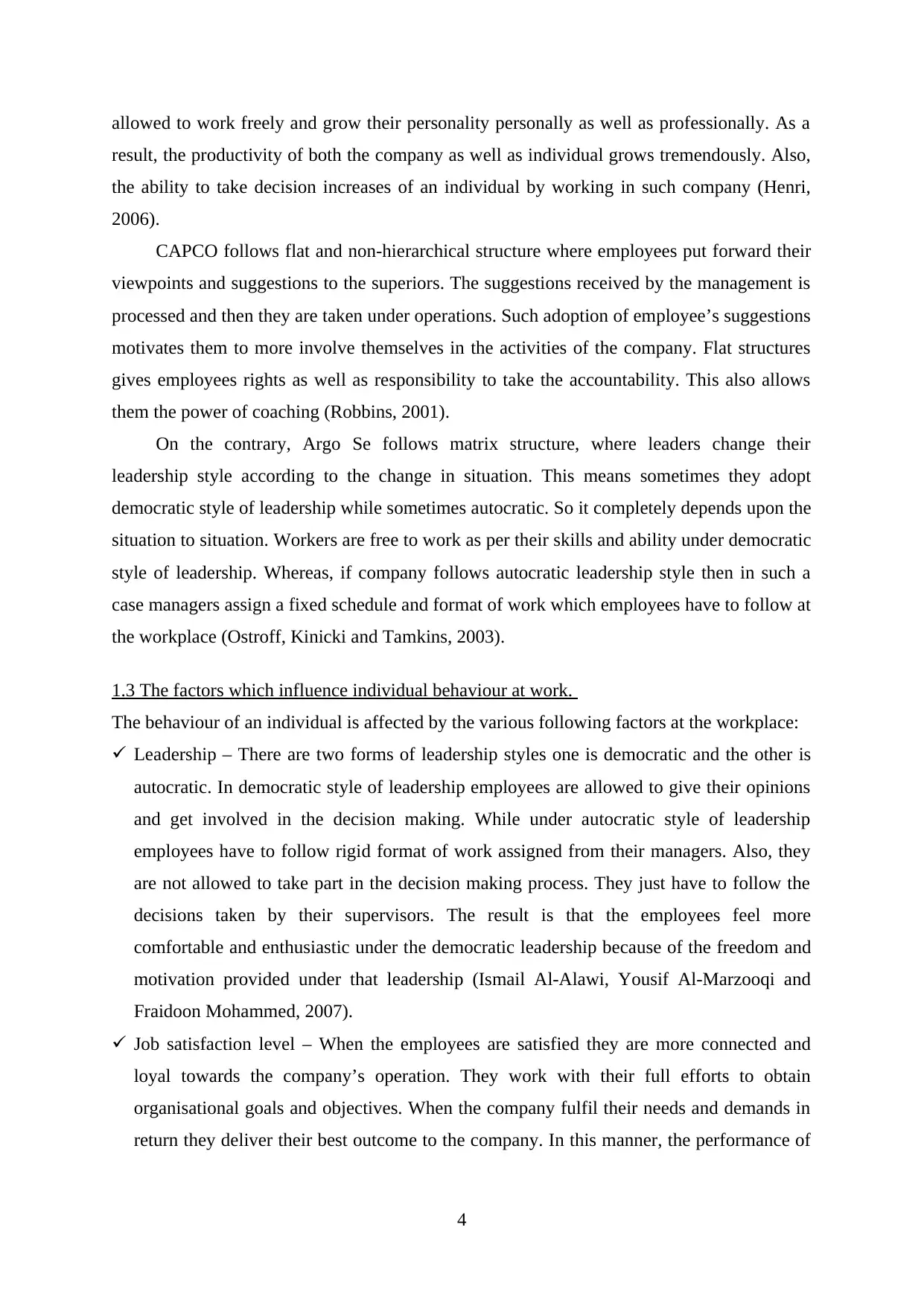
allowed to work freely and grow their personality personally as well as professionally. As a
result, the productivity of both the company as well as individual grows tremendously. Also,
the ability to take decision increases of an individual by working in such company (Henri,
2006).
CAPCO follows flat and non-hierarchical structure where employees put forward their
viewpoints and suggestions to the superiors. The suggestions received by the management is
processed and then they are taken under operations. Such adoption of employee’s suggestions
motivates them to more involve themselves in the activities of the company. Flat structures
gives employees rights as well as responsibility to take the accountability. This also allows
them the power of coaching (Robbins, 2001).
On the contrary, Argo Se follows matrix structure, where leaders change their
leadership style according to the change in situation. This means sometimes they adopt
democratic style of leadership while sometimes autocratic. So it completely depends upon the
situation to situation. Workers are free to work as per their skills and ability under democratic
style of leadership. Whereas, if company follows autocratic leadership style then in such a
case managers assign a fixed schedule and format of work which employees have to follow at
the workplace (Ostroff, Kinicki and Tamkins, 2003).
1.3 The factors which influence individual behaviour at work.
The behaviour of an individual is affected by the various following factors at the workplace:
Leadership – There are two forms of leadership styles one is democratic and the other is
autocratic. In democratic style of leadership employees are allowed to give their opinions
and get involved in the decision making. While under autocratic style of leadership
employees have to follow rigid format of work assigned from their managers. Also, they
are not allowed to take part in the decision making process. They just have to follow the
decisions taken by their supervisors. The result is that the employees feel more
comfortable and enthusiastic under the democratic leadership because of the freedom and
motivation provided under that leadership (Ismail Al-Alawi, Yousif Al-Marzooqi and
Fraidoon Mohammed, 2007).
Job satisfaction level – When the employees are satisfied they are more connected and
loyal towards the company’s operation. They work with their full efforts to obtain
organisational goals and objectives. When the company fulfil their needs and demands in
return they deliver their best outcome to the company. In this manner, the performance of
4
result, the productivity of both the company as well as individual grows tremendously. Also,
the ability to take decision increases of an individual by working in such company (Henri,
2006).
CAPCO follows flat and non-hierarchical structure where employees put forward their
viewpoints and suggestions to the superiors. The suggestions received by the management is
processed and then they are taken under operations. Such adoption of employee’s suggestions
motivates them to more involve themselves in the activities of the company. Flat structures
gives employees rights as well as responsibility to take the accountability. This also allows
them the power of coaching (Robbins, 2001).
On the contrary, Argo Se follows matrix structure, where leaders change their
leadership style according to the change in situation. This means sometimes they adopt
democratic style of leadership while sometimes autocratic. So it completely depends upon the
situation to situation. Workers are free to work as per their skills and ability under democratic
style of leadership. Whereas, if company follows autocratic leadership style then in such a
case managers assign a fixed schedule and format of work which employees have to follow at
the workplace (Ostroff, Kinicki and Tamkins, 2003).
1.3 The factors which influence individual behaviour at work.
The behaviour of an individual is affected by the various following factors at the workplace:
Leadership – There are two forms of leadership styles one is democratic and the other is
autocratic. In democratic style of leadership employees are allowed to give their opinions
and get involved in the decision making. While under autocratic style of leadership
employees have to follow rigid format of work assigned from their managers. Also, they
are not allowed to take part in the decision making process. They just have to follow the
decisions taken by their supervisors. The result is that the employees feel more
comfortable and enthusiastic under the democratic leadership because of the freedom and
motivation provided under that leadership (Ismail Al-Alawi, Yousif Al-Marzooqi and
Fraidoon Mohammed, 2007).
Job satisfaction level – When the employees are satisfied they are more connected and
loyal towards the company’s operation. They work with their full efforts to obtain
organisational goals and objectives. When the company fulfil their needs and demands in
return they deliver their best outcome to the company. In this manner, the performance of
4
⊘ This is a preview!⊘
Do you want full access?
Subscribe today to unlock all pages.

Trusted by 1+ million students worldwide
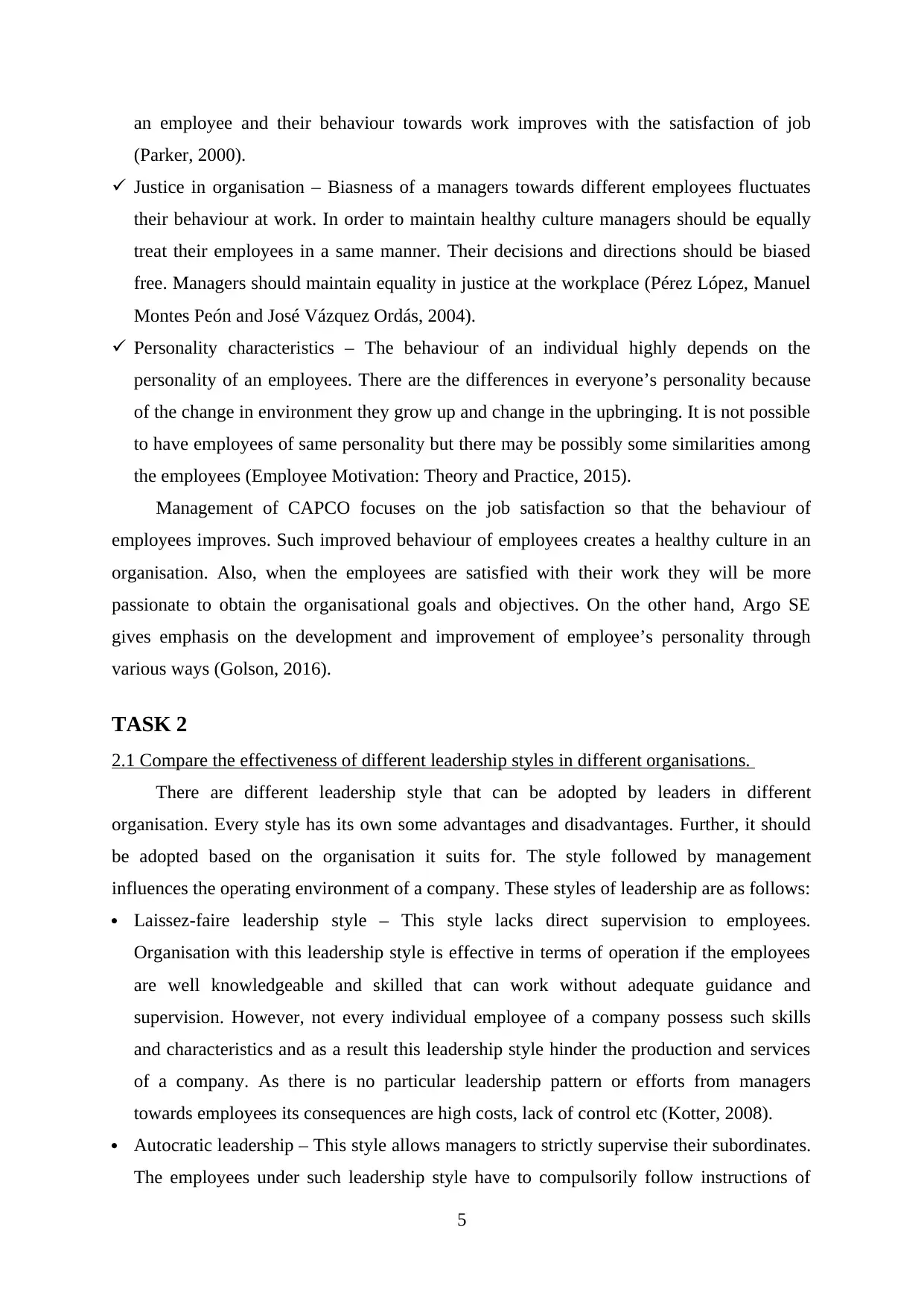
an employee and their behaviour towards work improves with the satisfaction of job
(Parker, 2000).
Justice in organisation – Biasness of a managers towards different employees fluctuates
their behaviour at work. In order to maintain healthy culture managers should be equally
treat their employees in a same manner. Their decisions and directions should be biased
free. Managers should maintain equality in justice at the workplace (Pérez López, Manuel
Montes Peón and José Vázquez Ordás, 2004).
Personality characteristics – The behaviour of an individual highly depends on the
personality of an employees. There are the differences in everyone’s personality because
of the change in environment they grow up and change in the upbringing. It is not possible
to have employees of same personality but there may be possibly some similarities among
the employees (Employee Motivation: Theory and Practice, 2015).
Management of CAPCO focuses on the job satisfaction so that the behaviour of
employees improves. Such improved behaviour of employees creates a healthy culture in an
organisation. Also, when the employees are satisfied with their work they will be more
passionate to obtain the organisational goals and objectives. On the other hand, Argo SE
gives emphasis on the development and improvement of employee’s personality through
various ways (Golson, 2016).
TASK 2
2.1 Compare the effectiveness of different leadership styles in different organisations.
There are different leadership style that can be adopted by leaders in different
organisation. Every style has its own some advantages and disadvantages. Further, it should
be adopted based on the organisation it suits for. The style followed by management
influences the operating environment of a company. These styles of leadership are as follows:
Laissez-faire leadership style – This style lacks direct supervision to employees.
Organisation with this leadership style is effective in terms of operation if the employees
are well knowledgeable and skilled that can work without adequate guidance and
supervision. However, not every individual employee of a company possess such skills
and characteristics and as a result this leadership style hinder the production and services
of a company. As there is no particular leadership pattern or efforts from managers
towards employees its consequences are high costs, lack of control etc (Kotter, 2008).
Autocratic leadership – This style allows managers to strictly supervise their subordinates.
The employees under such leadership style have to compulsorily follow instructions of
5
(Parker, 2000).
Justice in organisation – Biasness of a managers towards different employees fluctuates
their behaviour at work. In order to maintain healthy culture managers should be equally
treat their employees in a same manner. Their decisions and directions should be biased
free. Managers should maintain equality in justice at the workplace (Pérez López, Manuel
Montes Peón and José Vázquez Ordás, 2004).
Personality characteristics – The behaviour of an individual highly depends on the
personality of an employees. There are the differences in everyone’s personality because
of the change in environment they grow up and change in the upbringing. It is not possible
to have employees of same personality but there may be possibly some similarities among
the employees (Employee Motivation: Theory and Practice, 2015).
Management of CAPCO focuses on the job satisfaction so that the behaviour of
employees improves. Such improved behaviour of employees creates a healthy culture in an
organisation. Also, when the employees are satisfied with their work they will be more
passionate to obtain the organisational goals and objectives. On the other hand, Argo SE
gives emphasis on the development and improvement of employee’s personality through
various ways (Golson, 2016).
TASK 2
2.1 Compare the effectiveness of different leadership styles in different organisations.
There are different leadership style that can be adopted by leaders in different
organisation. Every style has its own some advantages and disadvantages. Further, it should
be adopted based on the organisation it suits for. The style followed by management
influences the operating environment of a company. These styles of leadership are as follows:
Laissez-faire leadership style – This style lacks direct supervision to employees.
Organisation with this leadership style is effective in terms of operation if the employees
are well knowledgeable and skilled that can work without adequate guidance and
supervision. However, not every individual employee of a company possess such skills
and characteristics and as a result this leadership style hinder the production and services
of a company. As there is no particular leadership pattern or efforts from managers
towards employees its consequences are high costs, lack of control etc (Kotter, 2008).
Autocratic leadership – This style allows managers to strictly supervise their subordinates.
The employees under such leadership style have to compulsorily follow instructions of
5
Paraphrase This Document
Need a fresh take? Get an instant paraphrase of this document with our AI Paraphraser
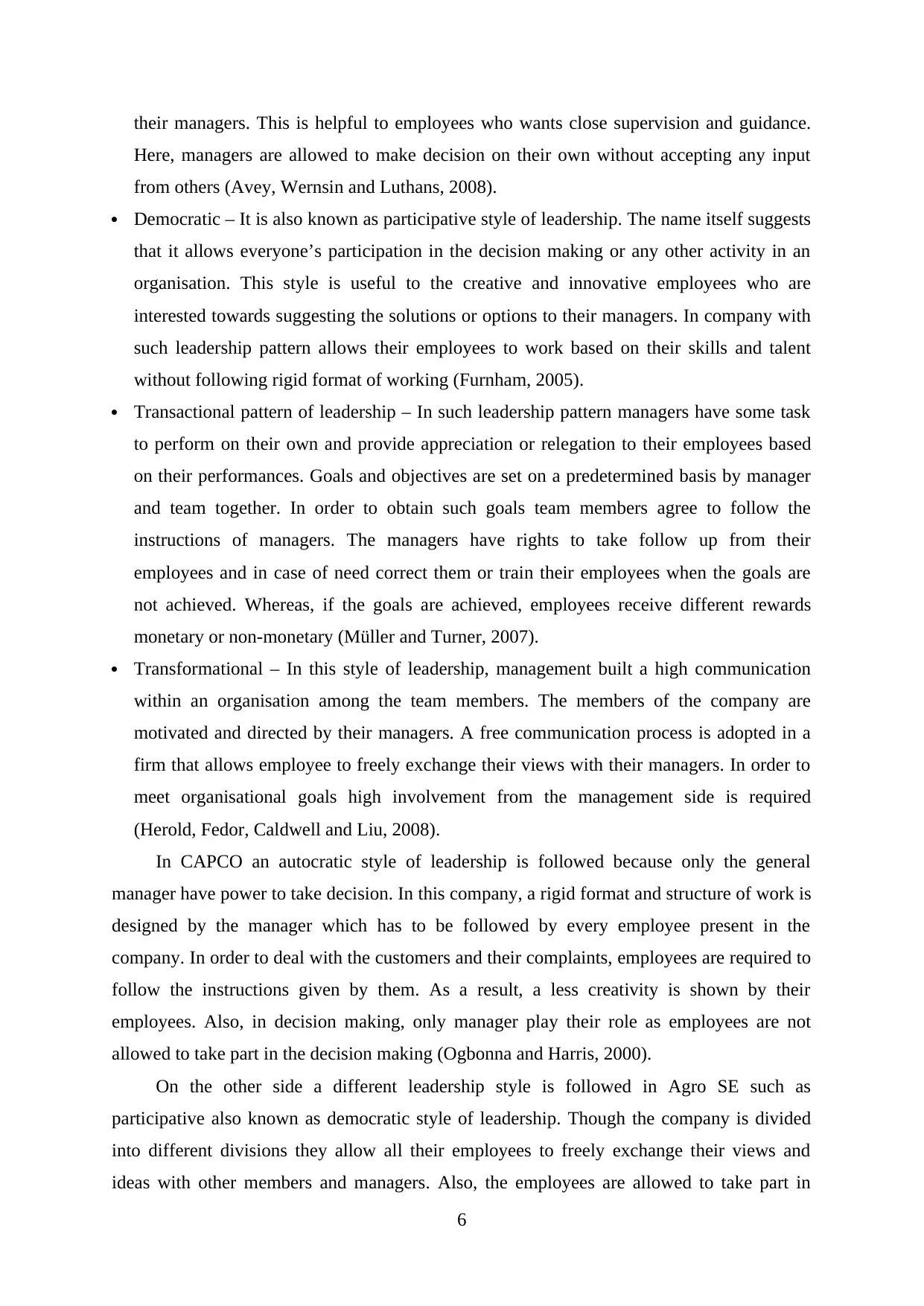
their managers. This is helpful to employees who wants close supervision and guidance.
Here, managers are allowed to make decision on their own without accepting any input
from others (Avey, Wernsin and Luthans, 2008).
Democratic – It is also known as participative style of leadership. The name itself suggests
that it allows everyone’s participation in the decision making or any other activity in an
organisation. This style is useful to the creative and innovative employees who are
interested towards suggesting the solutions or options to their managers. In company with
such leadership pattern allows their employees to work based on their skills and talent
without following rigid format of working (Furnham, 2005).
Transactional pattern of leadership – In such leadership pattern managers have some task
to perform on their own and provide appreciation or relegation to their employees based
on their performances. Goals and objectives are set on a predetermined basis by manager
and team together. In order to obtain such goals team members agree to follow the
instructions of managers. The managers have rights to take follow up from their
employees and in case of need correct them or train their employees when the goals are
not achieved. Whereas, if the goals are achieved, employees receive different rewards
monetary or non-monetary (Müller and Turner, 2007).
Transformational – In this style of leadership, management built a high communication
within an organisation among the team members. The members of the company are
motivated and directed by their managers. A free communication process is adopted in a
firm that allows employee to freely exchange their views with their managers. In order to
meet organisational goals high involvement from the management side is required
(Herold, Fedor, Caldwell and Liu, 2008).
In CAPCO an autocratic style of leadership is followed because only the general
manager have power to take decision. In this company, a rigid format and structure of work is
designed by the manager which has to be followed by every employee present in the
company. In order to deal with the customers and their complaints, employees are required to
follow the instructions given by them. As a result, a less creativity is shown by their
employees. Also, in decision making, only manager play their role as employees are not
allowed to take part in the decision making (Ogbonna and Harris, 2000).
On the other side a different leadership style is followed in Agro SE such as
participative also known as democratic style of leadership. Though the company is divided
into different divisions they allow all their employees to freely exchange their views and
ideas with other members and managers. Also, the employees are allowed to take part in
6
Here, managers are allowed to make decision on their own without accepting any input
from others (Avey, Wernsin and Luthans, 2008).
Democratic – It is also known as participative style of leadership. The name itself suggests
that it allows everyone’s participation in the decision making or any other activity in an
organisation. This style is useful to the creative and innovative employees who are
interested towards suggesting the solutions or options to their managers. In company with
such leadership pattern allows their employees to work based on their skills and talent
without following rigid format of working (Furnham, 2005).
Transactional pattern of leadership – In such leadership pattern managers have some task
to perform on their own and provide appreciation or relegation to their employees based
on their performances. Goals and objectives are set on a predetermined basis by manager
and team together. In order to obtain such goals team members agree to follow the
instructions of managers. The managers have rights to take follow up from their
employees and in case of need correct them or train their employees when the goals are
not achieved. Whereas, if the goals are achieved, employees receive different rewards
monetary or non-monetary (Müller and Turner, 2007).
Transformational – In this style of leadership, management built a high communication
within an organisation among the team members. The members of the company are
motivated and directed by their managers. A free communication process is adopted in a
firm that allows employee to freely exchange their views with their managers. In order to
meet organisational goals high involvement from the management side is required
(Herold, Fedor, Caldwell and Liu, 2008).
In CAPCO an autocratic style of leadership is followed because only the general
manager have power to take decision. In this company, a rigid format and structure of work is
designed by the manager which has to be followed by every employee present in the
company. In order to deal with the customers and their complaints, employees are required to
follow the instructions given by them. As a result, a less creativity is shown by their
employees. Also, in decision making, only manager play their role as employees are not
allowed to take part in the decision making (Ogbonna and Harris, 2000).
On the other side a different leadership style is followed in Agro SE such as
participative also known as democratic style of leadership. Though the company is divided
into different divisions they allow all their employees to freely exchange their views and
ideas with other members and managers. Also, the employees are allowed to take part in
6
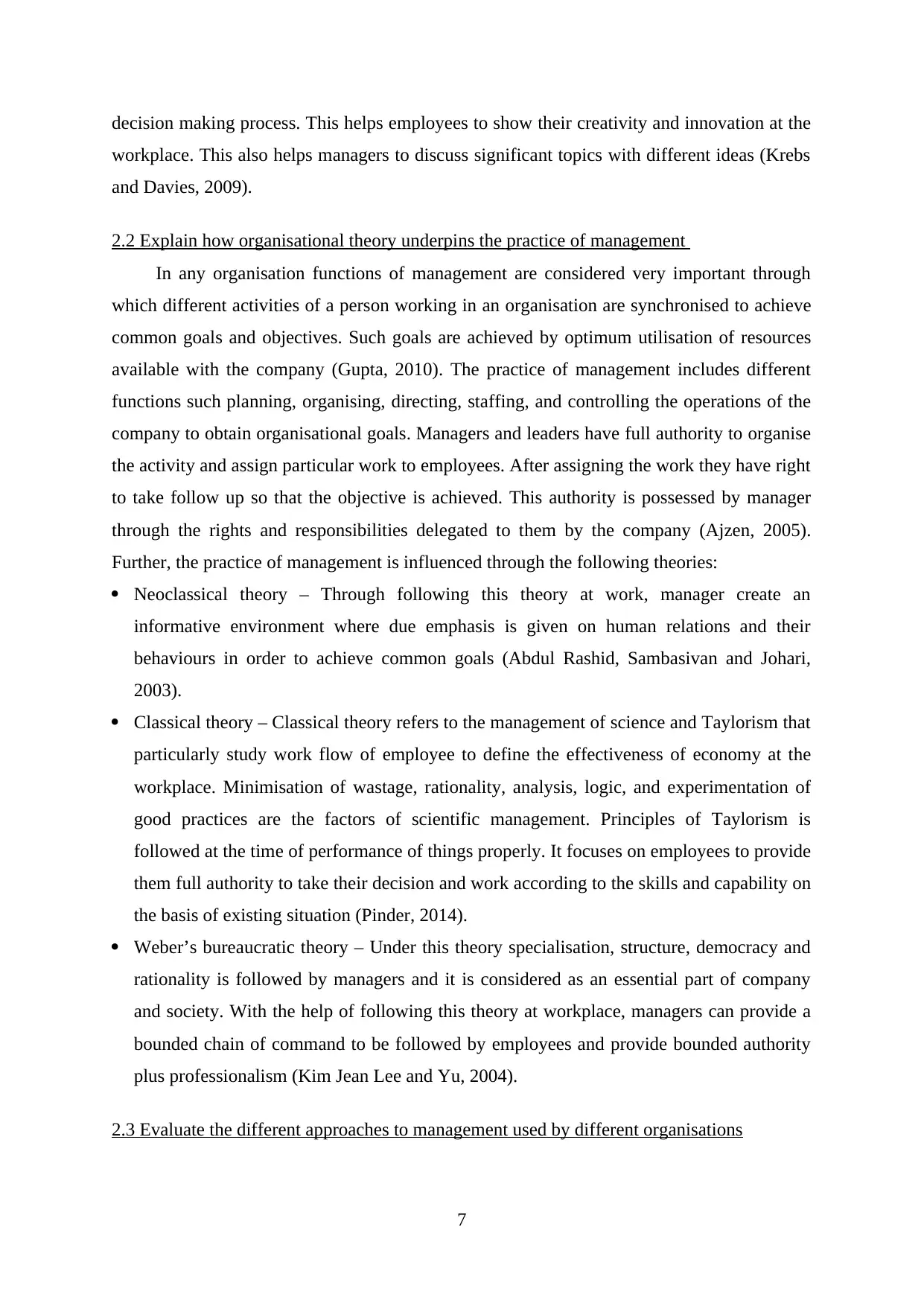
decision making process. This helps employees to show their creativity and innovation at the
workplace. This also helps managers to discuss significant topics with different ideas (Krebs
and Davies, 2009).
2.2 Explain how organisational theory underpins the practice of management
In any organisation functions of management are considered very important through
which different activities of a person working in an organisation are synchronised to achieve
common goals and objectives. Such goals are achieved by optimum utilisation of resources
available with the company (Gupta, 2010). The practice of management includes different
functions such planning, organising, directing, staffing, and controlling the operations of the
company to obtain organisational goals. Managers and leaders have full authority to organise
the activity and assign particular work to employees. After assigning the work they have right
to take follow up so that the objective is achieved. This authority is possessed by manager
through the rights and responsibilities delegated to them by the company (Ajzen, 2005).
Further, the practice of management is influenced through the following theories:
Neoclassical theory – Through following this theory at work, manager create an
informative environment where due emphasis is given on human relations and their
behaviours in order to achieve common goals (Abdul Rashid, Sambasivan and Johari,
2003).
Classical theory – Classical theory refers to the management of science and Taylorism that
particularly study work flow of employee to define the effectiveness of economy at the
workplace. Minimisation of wastage, rationality, analysis, logic, and experimentation of
good practices are the factors of scientific management. Principles of Taylorism is
followed at the time of performance of things properly. It focuses on employees to provide
them full authority to take their decision and work according to the skills and capability on
the basis of existing situation (Pinder, 2014).
Weber’s bureaucratic theory – Under this theory specialisation, structure, democracy and
rationality is followed by managers and it is considered as an essential part of company
and society. With the help of following this theory at workplace, managers can provide a
bounded chain of command to be followed by employees and provide bounded authority
plus professionalism (Kim Jean Lee and Yu, 2004).
2.3 Evaluate the different approaches to management used by different organisations
7
workplace. This also helps managers to discuss significant topics with different ideas (Krebs
and Davies, 2009).
2.2 Explain how organisational theory underpins the practice of management
In any organisation functions of management are considered very important through
which different activities of a person working in an organisation are synchronised to achieve
common goals and objectives. Such goals are achieved by optimum utilisation of resources
available with the company (Gupta, 2010). The practice of management includes different
functions such planning, organising, directing, staffing, and controlling the operations of the
company to obtain organisational goals. Managers and leaders have full authority to organise
the activity and assign particular work to employees. After assigning the work they have right
to take follow up so that the objective is achieved. This authority is possessed by manager
through the rights and responsibilities delegated to them by the company (Ajzen, 2005).
Further, the practice of management is influenced through the following theories:
Neoclassical theory – Through following this theory at work, manager create an
informative environment where due emphasis is given on human relations and their
behaviours in order to achieve common goals (Abdul Rashid, Sambasivan and Johari,
2003).
Classical theory – Classical theory refers to the management of science and Taylorism that
particularly study work flow of employee to define the effectiveness of economy at the
workplace. Minimisation of wastage, rationality, analysis, logic, and experimentation of
good practices are the factors of scientific management. Principles of Taylorism is
followed at the time of performance of things properly. It focuses on employees to provide
them full authority to take their decision and work according to the skills and capability on
the basis of existing situation (Pinder, 2014).
Weber’s bureaucratic theory – Under this theory specialisation, structure, democracy and
rationality is followed by managers and it is considered as an essential part of company
and society. With the help of following this theory at workplace, managers can provide a
bounded chain of command to be followed by employees and provide bounded authority
plus professionalism (Kim Jean Lee and Yu, 2004).
2.3 Evaluate the different approaches to management used by different organisations
7
⊘ This is a preview!⊘
Do you want full access?
Subscribe today to unlock all pages.

Trusted by 1+ million students worldwide
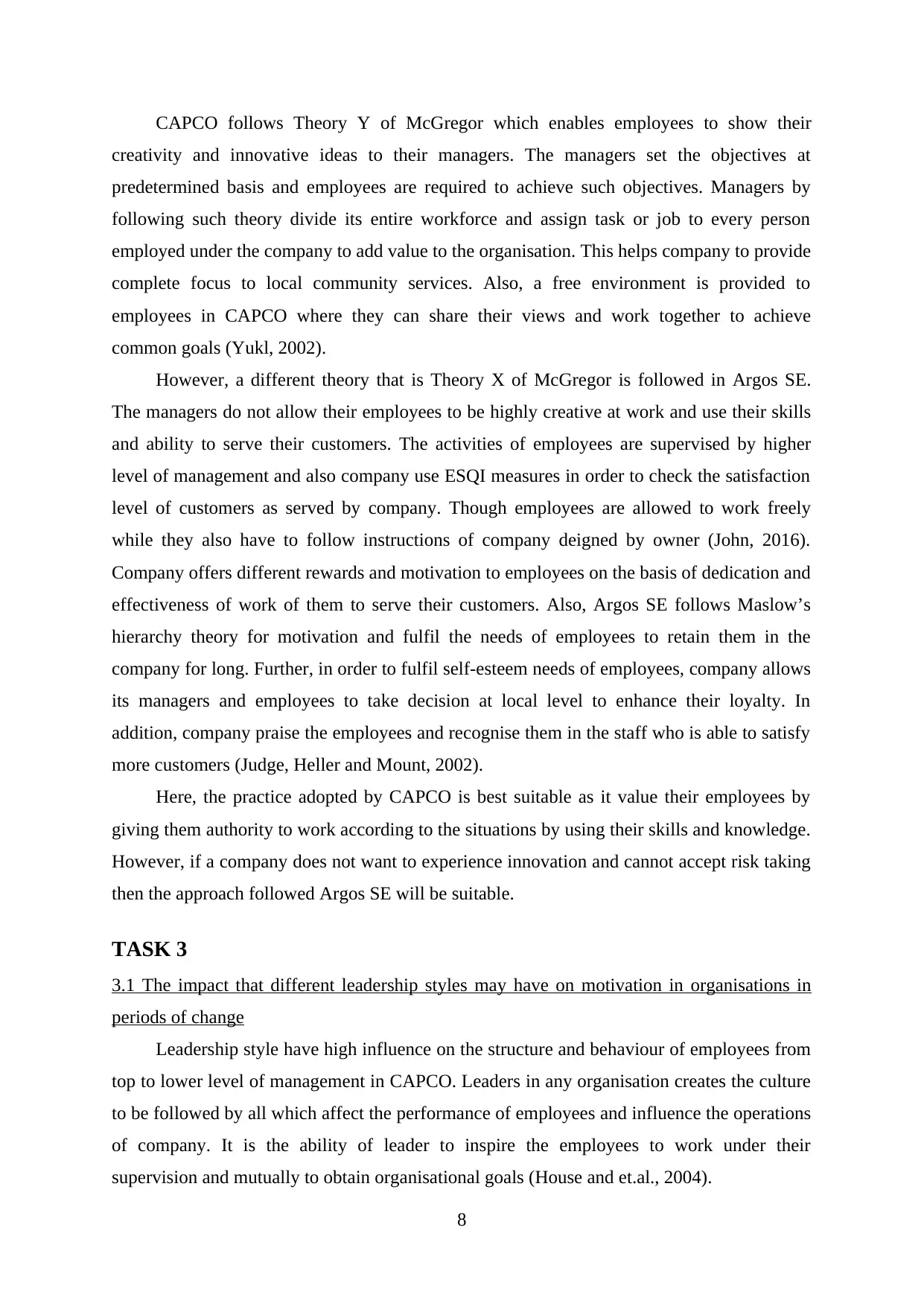
CAPCO follows Theory Y of McGregor which enables employees to show their
creativity and innovative ideas to their managers. The managers set the objectives at
predetermined basis and employees are required to achieve such objectives. Managers by
following such theory divide its entire workforce and assign task or job to every person
employed under the company to add value to the organisation. This helps company to provide
complete focus to local community services. Also, a free environment is provided to
employees in CAPCO where they can share their views and work together to achieve
common goals (Yukl, 2002).
However, a different theory that is Theory X of McGregor is followed in Argos SE.
The managers do not allow their employees to be highly creative at work and use their skills
and ability to serve their customers. The activities of employees are supervised by higher
level of management and also company use ESQI measures in order to check the satisfaction
level of customers as served by company. Though employees are allowed to work freely
while they also have to follow instructions of company deigned by owner (John, 2016).
Company offers different rewards and motivation to employees on the basis of dedication and
effectiveness of work of them to serve their customers. Also, Argos SE follows Maslow’s
hierarchy theory for motivation and fulfil the needs of employees to retain them in the
company for long. Further, in order to fulfil self-esteem needs of employees, company allows
its managers and employees to take decision at local level to enhance their loyalty. In
addition, company praise the employees and recognise them in the staff who is able to satisfy
more customers (Judge, Heller and Mount, 2002).
Here, the practice adopted by CAPCO is best suitable as it value their employees by
giving them authority to work according to the situations by using their skills and knowledge.
However, if a company does not want to experience innovation and cannot accept risk taking
then the approach followed Argos SE will be suitable.
TASK 3
3.1 The impact that different leadership styles may have on motivation in organisations in
periods of change
Leadership style have high influence on the structure and behaviour of employees from
top to lower level of management in CAPCO. Leaders in any organisation creates the culture
to be followed by all which affect the performance of employees and influence the operations
of company. It is the ability of leader to inspire the employees to work under their
supervision and mutually to obtain organisational goals (House and et.al., 2004).
8
creativity and innovative ideas to their managers. The managers set the objectives at
predetermined basis and employees are required to achieve such objectives. Managers by
following such theory divide its entire workforce and assign task or job to every person
employed under the company to add value to the organisation. This helps company to provide
complete focus to local community services. Also, a free environment is provided to
employees in CAPCO where they can share their views and work together to achieve
common goals (Yukl, 2002).
However, a different theory that is Theory X of McGregor is followed in Argos SE.
The managers do not allow their employees to be highly creative at work and use their skills
and ability to serve their customers. The activities of employees are supervised by higher
level of management and also company use ESQI measures in order to check the satisfaction
level of customers as served by company. Though employees are allowed to work freely
while they also have to follow instructions of company deigned by owner (John, 2016).
Company offers different rewards and motivation to employees on the basis of dedication and
effectiveness of work of them to serve their customers. Also, Argos SE follows Maslow’s
hierarchy theory for motivation and fulfil the needs of employees to retain them in the
company for long. Further, in order to fulfil self-esteem needs of employees, company allows
its managers and employees to take decision at local level to enhance their loyalty. In
addition, company praise the employees and recognise them in the staff who is able to satisfy
more customers (Judge, Heller and Mount, 2002).
Here, the practice adopted by CAPCO is best suitable as it value their employees by
giving them authority to work according to the situations by using their skills and knowledge.
However, if a company does not want to experience innovation and cannot accept risk taking
then the approach followed Argos SE will be suitable.
TASK 3
3.1 The impact that different leadership styles may have on motivation in organisations in
periods of change
Leadership style have high influence on the structure and behaviour of employees from
top to lower level of management in CAPCO. Leaders in any organisation creates the culture
to be followed by all which affect the performance of employees and influence the operations
of company. It is the ability of leader to inspire the employees to work under their
supervision and mutually to obtain organisational goals (House and et.al., 2004).
8
Paraphrase This Document
Need a fresh take? Get an instant paraphrase of this document with our AI Paraphraser
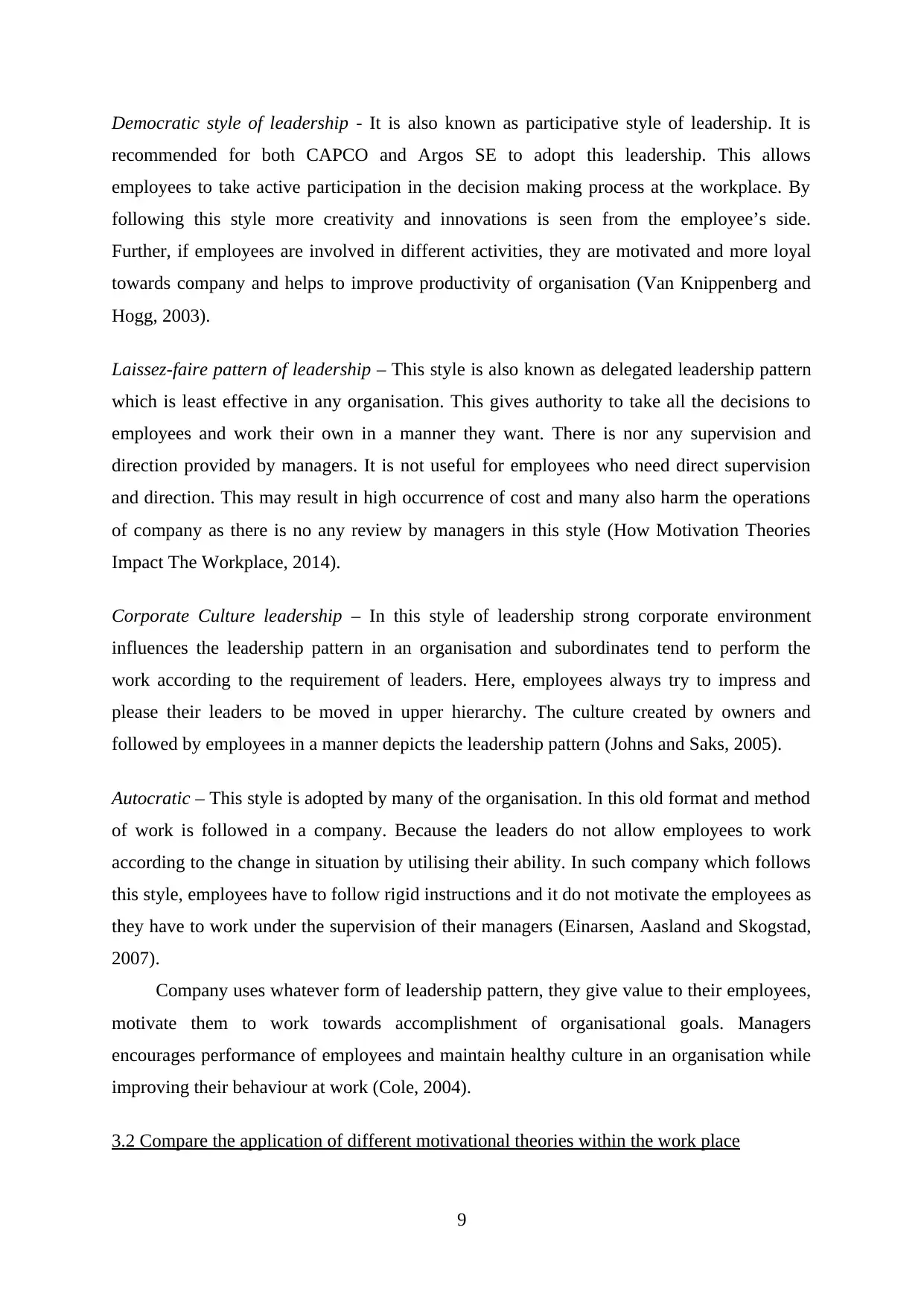
Democratic style of leadership - It is also known as participative style of leadership. It is
recommended for both CAPCO and Argos SE to adopt this leadership. This allows
employees to take active participation in the decision making process at the workplace. By
following this style more creativity and innovations is seen from the employee’s side.
Further, if employees are involved in different activities, they are motivated and more loyal
towards company and helps to improve productivity of organisation (Van Knippenberg and
Hogg, 2003).
Laissez-faire pattern of leadership – This style is also known as delegated leadership pattern
which is least effective in any organisation. This gives authority to take all the decisions to
employees and work their own in a manner they want. There is nor any supervision and
direction provided by managers. It is not useful for employees who need direct supervision
and direction. This may result in high occurrence of cost and many also harm the operations
of company as there is no any review by managers in this style (How Motivation Theories
Impact The Workplace, 2014).
Corporate Culture leadership – In this style of leadership strong corporate environment
influences the leadership pattern in an organisation and subordinates tend to perform the
work according to the requirement of leaders. Here, employees always try to impress and
please their leaders to be moved in upper hierarchy. The culture created by owners and
followed by employees in a manner depicts the leadership pattern (Johns and Saks, 2005).
Autocratic – This style is adopted by many of the organisation. In this old format and method
of work is followed in a company. Because the leaders do not allow employees to work
according to the change in situation by utilising their ability. In such company which follows
this style, employees have to follow rigid instructions and it do not motivate the employees as
they have to work under the supervision of their managers (Einarsen, Aasland and Skogstad,
2007).
Company uses whatever form of leadership pattern, they give value to their employees,
motivate them to work towards accomplishment of organisational goals. Managers
encourages performance of employees and maintain healthy culture in an organisation while
improving their behaviour at work (Cole, 2004).
3.2 Compare the application of different motivational theories within the work place
9
recommended for both CAPCO and Argos SE to adopt this leadership. This allows
employees to take active participation in the decision making process at the workplace. By
following this style more creativity and innovations is seen from the employee’s side.
Further, if employees are involved in different activities, they are motivated and more loyal
towards company and helps to improve productivity of organisation (Van Knippenberg and
Hogg, 2003).
Laissez-faire pattern of leadership – This style is also known as delegated leadership pattern
which is least effective in any organisation. This gives authority to take all the decisions to
employees and work their own in a manner they want. There is nor any supervision and
direction provided by managers. It is not useful for employees who need direct supervision
and direction. This may result in high occurrence of cost and many also harm the operations
of company as there is no any review by managers in this style (How Motivation Theories
Impact The Workplace, 2014).
Corporate Culture leadership – In this style of leadership strong corporate environment
influences the leadership pattern in an organisation and subordinates tend to perform the
work according to the requirement of leaders. Here, employees always try to impress and
please their leaders to be moved in upper hierarchy. The culture created by owners and
followed by employees in a manner depicts the leadership pattern (Johns and Saks, 2005).
Autocratic – This style is adopted by many of the organisation. In this old format and method
of work is followed in a company. Because the leaders do not allow employees to work
according to the change in situation by utilising their ability. In such company which follows
this style, employees have to follow rigid instructions and it do not motivate the employees as
they have to work under the supervision of their managers (Einarsen, Aasland and Skogstad,
2007).
Company uses whatever form of leadership pattern, they give value to their employees,
motivate them to work towards accomplishment of organisational goals. Managers
encourages performance of employees and maintain healthy culture in an organisation while
improving their behaviour at work (Cole, 2004).
3.2 Compare the application of different motivational theories within the work place
9
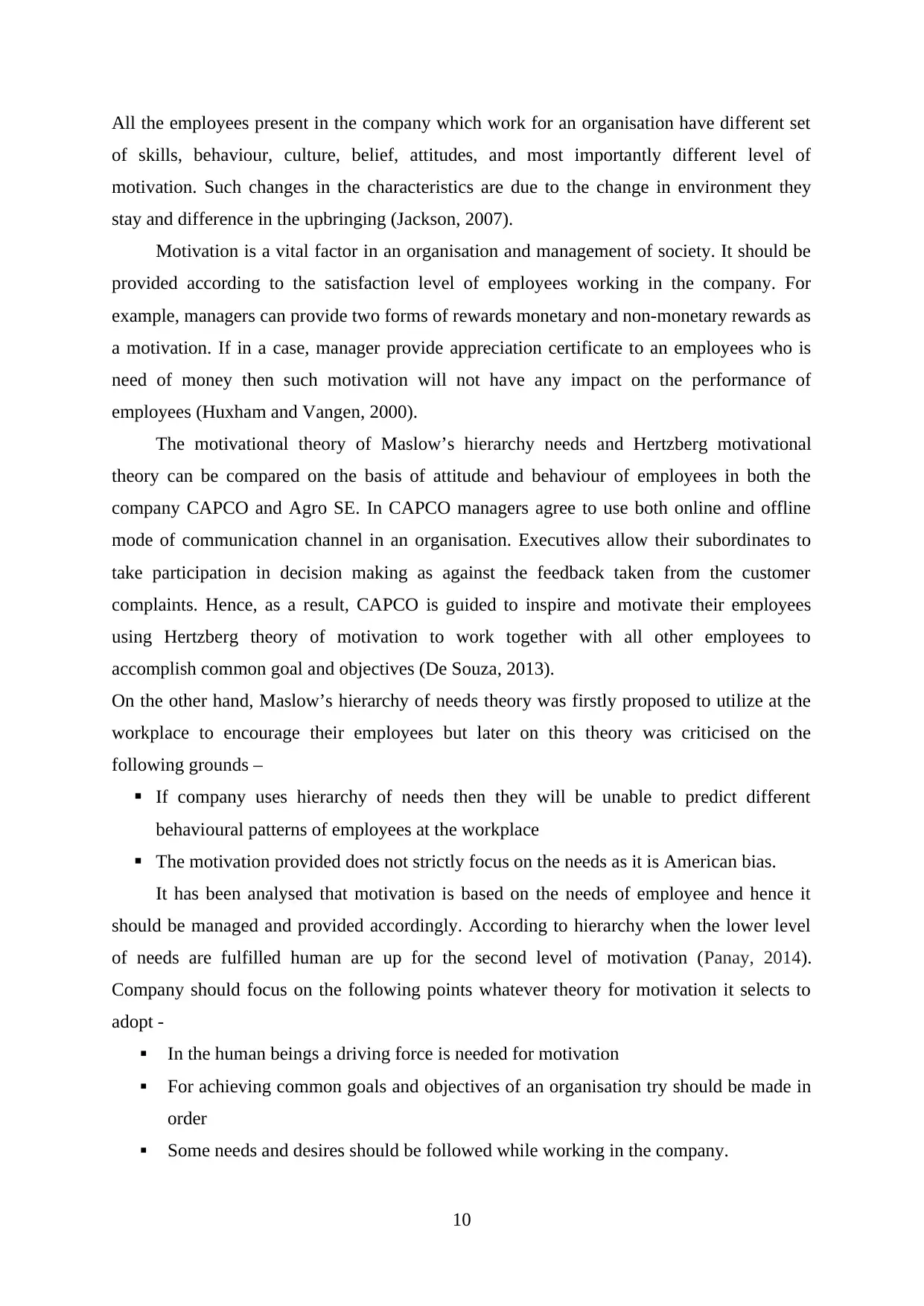
All the employees present in the company which work for an organisation have different set
of skills, behaviour, culture, belief, attitudes, and most importantly different level of
motivation. Such changes in the characteristics are due to the change in environment they
stay and difference in the upbringing (Jackson, 2007).
Motivation is a vital factor in an organisation and management of society. It should be
provided according to the satisfaction level of employees working in the company. For
example, managers can provide two forms of rewards monetary and non-monetary rewards as
a motivation. If in a case, manager provide appreciation certificate to an employees who is
need of money then such motivation will not have any impact on the performance of
employees (Huxham and Vangen, 2000).
The motivational theory of Maslow’s hierarchy needs and Hertzberg motivational
theory can be compared on the basis of attitude and behaviour of employees in both the
company CAPCO and Agro SE. In CAPCO managers agree to use both online and offline
mode of communication channel in an organisation. Executives allow their subordinates to
take participation in decision making as against the feedback taken from the customer
complaints. Hence, as a result, CAPCO is guided to inspire and motivate their employees
using Hertzberg theory of motivation to work together with all other employees to
accomplish common goal and objectives (De Souza, 2013).
On the other hand, Maslow’s hierarchy of needs theory was firstly proposed to utilize at the
workplace to encourage their employees but later on this theory was criticised on the
following grounds –
If company uses hierarchy of needs then they will be unable to predict different
behavioural patterns of employees at the workplace
The motivation provided does not strictly focus on the needs as it is American bias.
It has been analysed that motivation is based on the needs of employee and hence it
should be managed and provided accordingly. According to hierarchy when the lower level
of needs are fulfilled human are up for the second level of motivation (Panay, 2014).
Company should focus on the following points whatever theory for motivation it selects to
adopt -
In the human beings a driving force is needed for motivation
For achieving common goals and objectives of an organisation try should be made in
order
Some needs and desires should be followed while working in the company.
10
of skills, behaviour, culture, belief, attitudes, and most importantly different level of
motivation. Such changes in the characteristics are due to the change in environment they
stay and difference in the upbringing (Jackson, 2007).
Motivation is a vital factor in an organisation and management of society. It should be
provided according to the satisfaction level of employees working in the company. For
example, managers can provide two forms of rewards monetary and non-monetary rewards as
a motivation. If in a case, manager provide appreciation certificate to an employees who is
need of money then such motivation will not have any impact on the performance of
employees (Huxham and Vangen, 2000).
The motivational theory of Maslow’s hierarchy needs and Hertzberg motivational
theory can be compared on the basis of attitude and behaviour of employees in both the
company CAPCO and Agro SE. In CAPCO managers agree to use both online and offline
mode of communication channel in an organisation. Executives allow their subordinates to
take participation in decision making as against the feedback taken from the customer
complaints. Hence, as a result, CAPCO is guided to inspire and motivate their employees
using Hertzberg theory of motivation to work together with all other employees to
accomplish common goal and objectives (De Souza, 2013).
On the other hand, Maslow’s hierarchy of needs theory was firstly proposed to utilize at the
workplace to encourage their employees but later on this theory was criticised on the
following grounds –
If company uses hierarchy of needs then they will be unable to predict different
behavioural patterns of employees at the workplace
The motivation provided does not strictly focus on the needs as it is American bias.
It has been analysed that motivation is based on the needs of employee and hence it
should be managed and provided accordingly. According to hierarchy when the lower level
of needs are fulfilled human are up for the second level of motivation (Panay, 2014).
Company should focus on the following points whatever theory for motivation it selects to
adopt -
In the human beings a driving force is needed for motivation
For achieving common goals and objectives of an organisation try should be made in
order
Some needs and desires should be followed while working in the company.
10
⊘ This is a preview!⊘
Do you want full access?
Subscribe today to unlock all pages.

Trusted by 1+ million students worldwide
1 out of 21
Related Documents
Your All-in-One AI-Powered Toolkit for Academic Success.
+13062052269
info@desklib.com
Available 24*7 on WhatsApp / Email
![[object Object]](/_next/static/media/star-bottom.7253800d.svg)
Unlock your academic potential
Copyright © 2020–2025 A2Z Services. All Rights Reserved. Developed and managed by ZUCOL.





